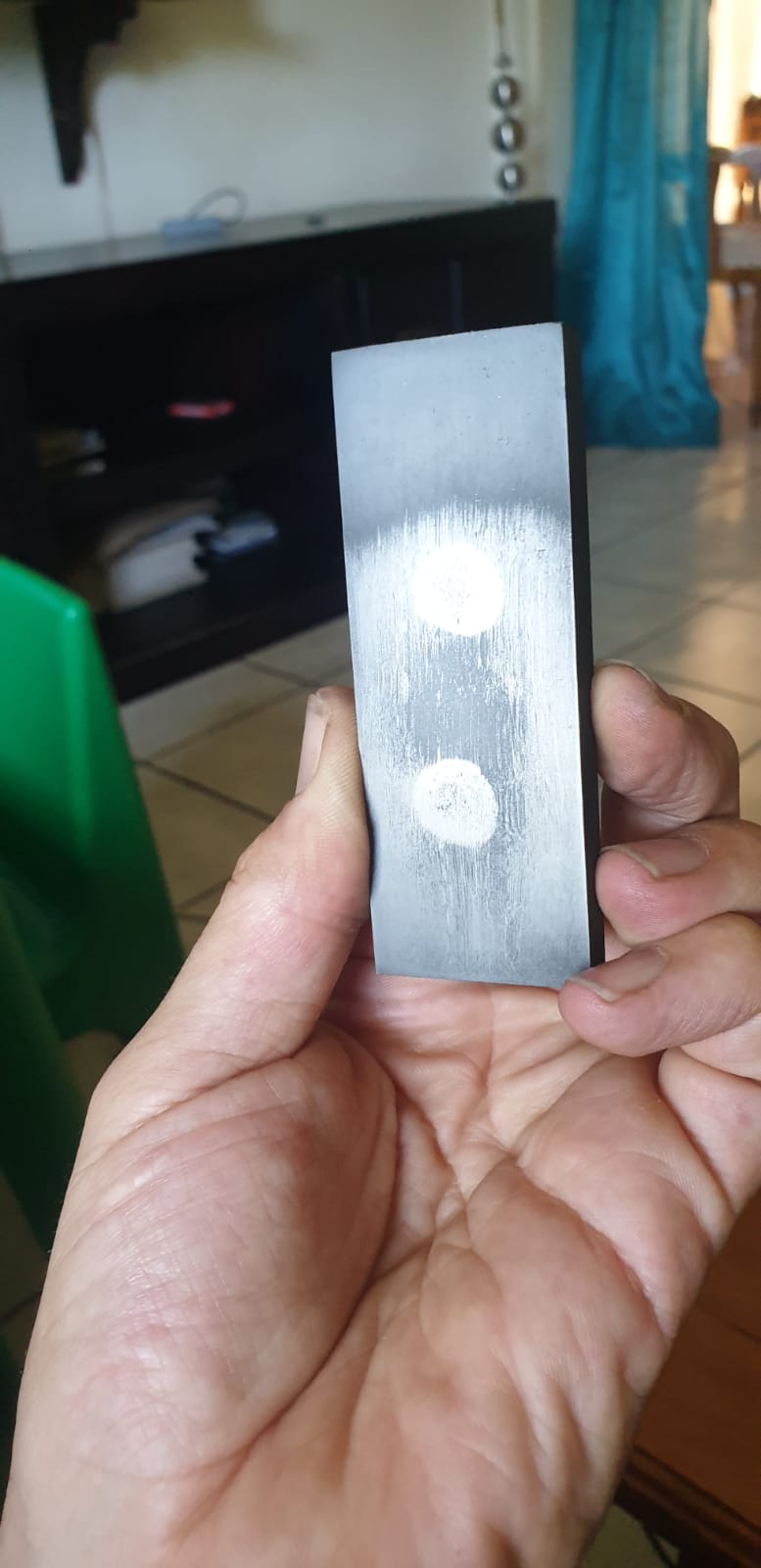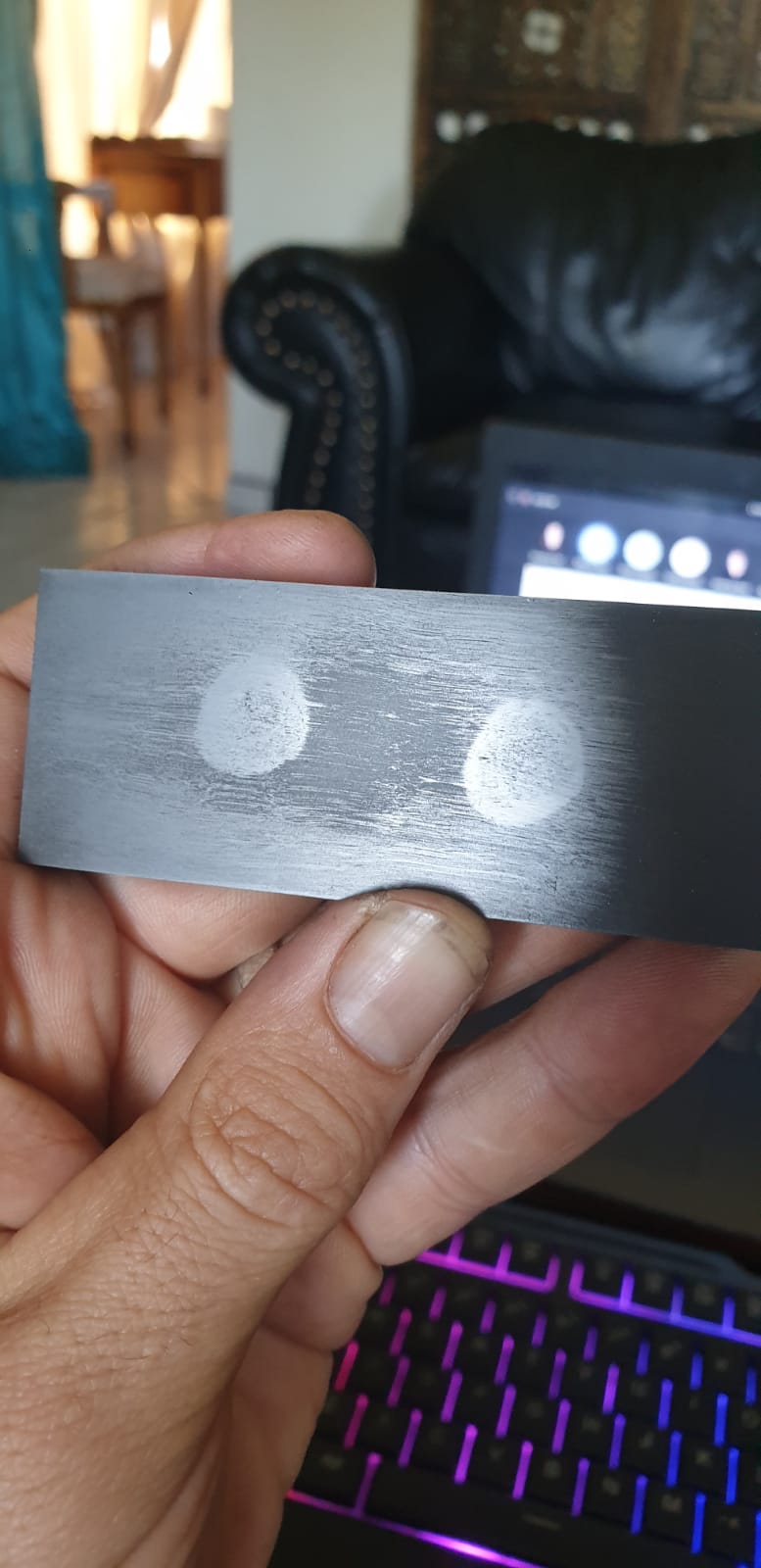Quote from Raggedyman on January 12, 2023, 1:55 amNot having a furnace that will melt ferrous materials or a crucible to hold it yet I tried an experiment with grain boundry carbide instead of dendritic carbide.
52100 bearing, massive grain structure induced and surface decarburizing done by throwing it into the forge while doing some forge-welding, then leaving it there to cool slowly.
Forged out at 820 Celsius.
Etching afterward showed a very fine grain pattern (as expected).
After etching I ground it clean again, and again heated up to 820 Celsius, held for 10 minutes. Once heated I hit it twice with the hammer, hammering two indentations into the piece. The premise I was operating on was that deformation of the carbide pattern should be clearly visible afterward (to ensure that what I was seeing is indeed carbide pattern and not some other peculiarity).
Quenched and ground the piece flat again, then polished and etched. The result was clearly evident.
Not having a furnace that will melt ferrous materials or a crucible to hold it yet I tried an experiment with grain boundry carbide instead of dendritic carbide.
52100 bearing, massive grain structure induced and surface decarburizing done by throwing it into the forge while doing some forge-welding, then leaving it there to cool slowly.
Forged out at 820 Celsius.
Etching afterward showed a very fine grain pattern (as expected).
After etching I ground it clean again, and again heated up to 820 Celsius, held for 10 minutes. Once heated I hit it twice with the hammer, hammering two indentations into the piece. The premise I was operating on was that deformation of the carbide pattern should be clearly visible afterward (to ensure that what I was seeing is indeed carbide pattern and not some other peculiarity).
Quenched and ground the piece flat again, then polished and etched. The result was clearly evident.
Uploaded files:Quote from Raggedyman on January 12, 2023, 2:07 amAs an aside
I believe the end that etched dark would be the part that I held with the tongs during the hammering. It would (I expect) have cooled quickly enough to form some martensite. Interresting as well is the fact that it seems difficult to get a discernable pattern there.
Secondly, assessing the 2 hammer marks: It seems the pattern has been mostly removed there, this leads to two hypothesis:
1: I hit them rather hard, and know from experience that hitting solidly will produce localised heating of a piece. Possibly it heat up enough to dissolve carbides. This I deem possible, but unlikely.
2: The grains were broken very finely by the hammer blows, leading to there being very little left in terms of pattern, which leads to the question of why it shows a clean etch instead of a dark one at those points. Reading up on it a little it seems iron etches darkly (martensite included), however carbide etches bright, thus cementite laminates being visible as brighter areas under a microscope when looking at pearlite.
All in all a big success in my world. No wootz made obviously, but a successful experiment in for proof of concept for decarburizing , inducing a pattern, and pattern manipulation.
As an aside
I believe the end that etched dark would be the part that I held with the tongs during the hammering. It would (I expect) have cooled quickly enough to form some martensite. Interresting as well is the fact that it seems difficult to get a discernable pattern there.
Secondly, assessing the 2 hammer marks: It seems the pattern has been mostly removed there, this leads to two hypothesis:
1: I hit them rather hard, and know from experience that hitting solidly will produce localised heating of a piece. Possibly it heat up enough to dissolve carbides. This I deem possible, but unlikely.
2: The grains were broken very finely by the hammer blows, leading to there being very little left in terms of pattern, which leads to the question of why it shows a clean etch instead of a dark one at those points. Reading up on it a little it seems iron etches darkly (martensite included), however carbide etches bright, thus cementite laminates being visible as brighter areas under a microscope when looking at pearlite.
All in all a big success in my world. No wootz made obviously, but a successful experiment in for proof of concept for decarburizing , inducing a pattern, and pattern manipulation.
Quote from Jacob Christian on January 17, 2023, 8:06 amVery interesting indeed! You say that those two round spots are from hammer blows?
Very interesting indeed! You say that those two round spots are from hammer blows?
Quote from Raggedyman on April 4, 2023, 2:24 pmSorry for the extremely late reply, I have been trying to get my ducks in a row on building a furnace, crucibles, and some form of power hammer/press that could be used to hammer out an ingot.
Yes - the round spots were made by hammer blow - Although the images do not quite show that the surface is even and polished, it was before etching. Those are carbide distortions, not indentations, for which I was quite happy
On the use of Chromium steels to produce a wootz effect: I have recently read up Juha Perttula's description of how he made "wootz" with a decent pattern derived from dendritic formation after melting using Chromium instead of Vanadium (I attach one of his articles - I believe he would not mind as he provided them freely).
I was very surprised that this would work, as I expected the temperature for chromium carbides to dissolve would be too low to allow for them to survive the initial forging and shell-decarburising.
However he was kind enough to respond to requests for information on this, and in his response stated that
"Cr carbides dissolve easily, but Cr enhance carbide formation, and thus the first carbides nucleates Cr-rich segregation, and thereafter they grow during low temperature cycles. I used Cr because it effectively prevents graphite formation, which may be a problem with super high carbon steels. So, wootz making with Cr is easier than with V."
I am looking forward to trying this out (again, when I can get all my stuff sorted). Was thinking that adding a small amount of m390 (which is one of the steels available here in South Africa - our selection isn't as great as in the west) for chrome up until about 0.3 percent along with the vanadium could prove interresting.
The Chromium would also assist in hardenability while (hopefully) not contributing to pattern loss as Manganese would
Sorry for the extremely late reply, I have been trying to get my ducks in a row on building a furnace, crucibles, and some form of power hammer/press that could be used to hammer out an ingot.
Yes - the round spots were made by hammer blow - Although the images do not quite show that the surface is even and polished, it was before etching. Those are carbide distortions, not indentations, for which I was quite happy
On the use of Chromium steels to produce a wootz effect: I have recently read up Juha Perttula's description of how he made "wootz" with a decent pattern derived from dendritic formation after melting using Chromium instead of Vanadium (I attach one of his articles - I believe he would not mind as he provided them freely).
I was very surprised that this would work, as I expected the temperature for chromium carbides to dissolve would be too low to allow for them to survive the initial forging and shell-decarburising.
However he was kind enough to respond to requests for information on this, and in his response stated that
"Cr carbides dissolve easily, but Cr enhance carbide formation, and thus the first carbides nucleates Cr-rich segregation, and thereafter they grow during low temperature cycles. I used Cr because it effectively prevents graphite formation, which may be a problem with super high carbon steels. So, wootz making with Cr is easier than with V."
I am looking forward to trying this out (again, when I can get all my stuff sorted). Was thinking that adding a small amount of m390 (which is one of the steels available here in South Africa - our selection isn't as great as in the west) for chrome up until about 0.3 percent along with the vanadium could prove interresting.
The Chromium would also assist in hardenability while (hopefully) not contributing to pattern loss as Manganese would
Uploaded files:Quote from Raggedyman on April 4, 2023, 2:27 pmOh, I also forgot to mention that one of the reasons I was considering this is that a melt might be easier, seeing as Chromium lowers the melting temperature for iron much the same as carbon does (although the amount would be minimal seeing as the chromium addition is very small, nut hey, every bit helps I guess)
Oh, I also forgot to mention that one of the reasons I was considering this is that a melt might be easier, seeing as Chromium lowers the melting temperature for iron much the same as carbon does (although the amount would be minimal seeing as the chromium addition is very small, nut hey, every bit helps I guess)
Quote from Jacob Christian on April 5, 2023, 10:13 amVery interesting that you bring this up. I saw some work from another maker and he is using higher Cr levels (.07) with high V levels(.025). On the upcoming ingot I will be doing .07 Cr with around .012 V because like you say the V is difficult to dissolve which means that growing the carbides through Ostwald ripening is also very difficult. I have the watery effect down but now need to work on coarsening the carbides.
Very interesting that you bring this up. I saw some work from another maker and he is using higher Cr levels (.07) with high V levels(.025). On the upcoming ingot I will be doing .07 Cr with around .012 V because like you say the V is difficult to dissolve which means that growing the carbides through Ostwald ripening is also very difficult. I have the watery effect down but now need to work on coarsening the carbides.
Quote from Jacob Christian on April 5, 2023, 10:20 amOh jeez haha started reading the article you linked and yeah he is definitely using a HIGH amount of Cr!
Oh jeez haha started reading the article you linked and yeah he is definitely using a HIGH amount of Cr!

